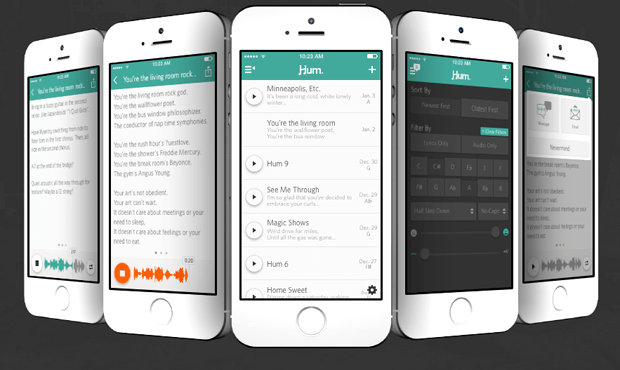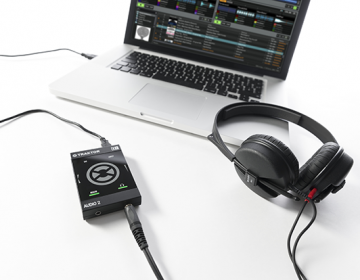Hum, An iPhone App for the Mobile Songwriter

As a songwriter, inspiration often strikes at the least opportune times. It’s easy to envision a musician scrambling for a pen and a pad, repeating a lyric and melody before the miraculous musical idea fades as quickly as it appeared. The advent of mobile technology seemed to somewhat streamline the songwriting process with digital note pads and dictaphones on command, making it relatively easy to jot down and record ideas on the go. But every technological invention has its limitations, and since Apple isn’t catering to the “mobile songwriting” niche, Notes and Voice Recorder offer no real method of in-app and inter-app integration and organization.
Aaron Shekey and Joseph Kuefler have created a much an easier way for songwriters to keep track of their ideas. With their new app Hum, lyrics and recorded melodies are combined in a single app, a surprisingly simple feat that few other apps have tackled. In a minimal and navigable interface with few frills, Hum offers a unique and highly efficient option for quick songwriting, plus easy sharing opportunities to collaborate with fellow musicians. Though the app is still in its nascent stage, Hum’s flexibility and straightforwardness open possibilities for expansion and growth in the near future, possibly revolutionizing the way we write songs on our phones.
Hum sports a cool green and white screen, with a light font that’s easy to read. Opening the app will take you directly to your list of songs, and a variety of sort options from the drop-down menu will help you navigate your notebook. You can filter your songs by date, note type (lyrics or audio, or both), key, guitar tuning (of which there are many, many listed), capo position, and mood. There are also two sliders which denote mood and timbre or energy. Within each note, the filters can beadjusted to organize each song accordingly. Recording your voice is pretty straightforward — press the big record button and play back from within the note or from the quick player in list view.
We had a chance to catch up with Aaron Shekey, one of the Hum founders, to talk briefly about the app and its plans for the future.
1. Where is the Hum team from, and what are your backgrounds?
Hum began and continues to be driven out of Minneapolis, MN, one of the country’s greatest music cities. Aaron cut his teeth designing websites for big brands. He later moved to San Francisco to work for Adobe. There he conceived of, designed and helped to build Edge Reflow, the first responsive web design application. Joseph spent years working as Creative Lead at Zeus Jones, a modern brand agency. While there, he led creative and strategic efforts for brands like Google, Purina and General Mills.
3. You have filters for key and capo, is Hum made especially for acoustic singer-songwriters?
4. Do you think you may integrate other sounds and/or instruments (like a mobile keyboard or drum sequencer) in the future to record melodies and rhythms on the fly?
7. What kind of syncing does Hum offer to back up songs?
8. Do you plan on partnering with any other platforms to expand the reach and functionality of the app (i.e. Audiobus, SoundCloud, etc.)?










